ARISTON FZ 990 C.1 IX -HA, FZ 99 C.1 -HA, FZ 99 C.1 IX -HA, FQ 99 C.1 -HA, FZ 992 C.1 -HA User Manual [ru]
...
Istruzioni per l’uso
FORNO
|
|
|
|
|
|
|
|
|
|
|
|
|
|
|
|
Sommario |
|
|
|
|
|
|
|
|
IT |
|
|
|
|
|
|
|
|
Installazione, 2-3 |
|
|
|
|
|
|
|
|
|
|
|
IT |
|
GB |
|
FR |
|
|
|
|
|
|
|
Posizionamento |
||||
|
|
|
|
|
|
|
Collegamento elettrico |
|
|
|
|
|
|
|
|
||
|
Italiano, 1 |
English,13 |
Français, 25 |
Dati tecnici |
||||
|
|
|
|
|
|
|
Descrizione dell’apparecchio, 4 |
|
|
ES |
|
PT |
|
RS |
|
||
|
|
|
|
Vista d’insieme |
||||
|
|
|
|
|
|
|
Pannello di controllo |
|
|
Espanol, 37 |
Portuges, 49 |
, 61 |
|||||
|
Display |
|||||||
|
|
|
|
|
|
|
Avvio e utilizzo, 5 |
|
|
|
|
|
|
|
|
Impostare l’orologio |
|
|
|
|
|
|
|
|
Impostare il contaminuti |
|
|
|
|
|
|
|
|
Avviare il forno |
|
|
|
|
|
|
|
|
Programmi, 6-8 |
|
FZ 990 C.1 /HA |
|
|
Programmi di cottura |
|||||
|
|
Programmare la cottura |
||||||
FZ 990 C.1 IX /HA |
|
|
Consigli pratici di cottura |
|||||
FZ 99 C.1 /HA |
|
|
Tabella cottura |
|||||
FZ 99 C.1 IX /HA |
|
|
|
|
||||
FQ 99 C.1 /HA |
|
|
Precauzioni e consigli, 9 |
|||||
FZ 992 C.1 /HA |
|
|
Sicurezza generale |
|||||
FZ 992 C.1 IX /HA |
|
|
Smaltimento |
|||||
FB 99 C.1 /HA |
|
|
Risparmiare e rispettare l’ambiente |
|||||
FB 99 C. 1 IX /HA |
|
|
|
|
||||
FD 99 C.1/HA |
|
|
Manutenzione e cura, 10-11 |
|||||
F 99 C.1 /HA |
|
|
Escludere la corrente elettrica |
|||||
F 99 C.1 IX /HA |
|
|
Pulire l’apparecchio |
|||||
F 89.1/HA |
|
|
|
|
Pulire la porta |
|||
F 89.1 IX/HA |
|
|
Sostituire la lampadina |
|||||
FH 99 C /HA |
|
|
Montaggio del Kit Guide Scorrevoli |
|||||
FH 99 C IX /HA |
|
|
|
|
||||
FH 997 C IX/HA |
|
|
Assistenza, 12 |
|||||
FH 997 C /HA |
|
|
Assistenza attiva 7 giorni su 7 |
|||||
FH 899 XA/HA |
|
|
|
|
||||
FH 899C XA/HA |
|
|
|
|
||||
1

Installazione
! È importante conservare questo libretto per poterlo IT consultare in ogni momento. In caso di vendita, di
cessione o di trasloco, assicurarsi che resti insieme all’apparecchio per informare il nuovo proprietario sul funzionamento e sui relativi avvertimenti.
! Leggere attentamente le istruzioni: ci sono importanti informazioni sull’installazione, sull’uso e sulla sicurezza.
Posizionamento
!Gli imballaggi non sono giocattoli per bambini e vanno eliminati secondo le norme per la raccolta differenziata (vedi Precauzioni e consigli).
!L’installazione va effettuata secondo queste istruzioni e da personale professionalmente qualificato. Una errata installazione può causare danni a persone, animali o cose.
Incasso
Per garantire un buon funzionamento dell’apparecchio è necessario che il mobile abbia le caratteristiche adatte:
•i pannelli adiacenti il forno devono essere di materiale resistente al calore;
•nel caso di mobili in legno impiallacciato, le colle devono essere resistenti alla temperatura di 100°C;
•per l’incasso del forno, sia nel caso di inserimento sottotavolo (vedi figura) che a colonna, il mobile deve avere le seguenti dimensioni:
|
|
|
. |
|
23 mm. |
|
.min |
|
|
mm |
|
mm.595 |
mm.567 |
547 |
|
585-575mm. |
|||
|
|
|
. |
|
|
|
mm |
|
|
|
45 |
|
|
560 |
mm. |
|
|
|
|
595 |
|
5 mm. |
|
mm. |
. |
|
|
|
mm |
|
|
|
|
545 |
|
|
. |
|
|
|
mm |
|
|
24 |
|
|
|
! Una volta incassato l’apparecchio non debbono essere possibili contatti con le parti elettriche. Le dichiarazioni di consumo indicate in targhetta
caratteristiche sono state misurate con questo tipo di installazione
Aerazione
Per garantire una buona aerazione è necessario eliminare la parete posteriore del vano. È preferibile installare il forno in modo che appoggi su due listelli in legno oppure su piano continuo che abbia un’apertura di almeno 45 x 560 mm (vedi figure).
. |
45 |
m |
|
mm |
|
m |
. |
560 |
|
|
|
Centraggio e fissaggio
Regolare i 4 tacchetti posti lateralmente al forno, in corrispondenza dei 4 fori sulla cornice perimetrale, in base allo spessore della fiancata del mobile:
spessore di 20 mm: rimuovere la parte mobile del tacchetto
(vedi figura);
spessore di 18 mm: utilizzare la prima scanalatura, come già predisposto dal fabbricante
(vedi figura);
spessore di 16 mm: utilizzare la seconda scanalatura
(vedi figura).
Per fissare l’apparecchio al mobile: aprire la porta del forno e avvitare 4 viti a legno nei 4 fori posti sulla cornice perimetrale.
! Tutte le parti che assicurano la protezione debbono essere fissate in modo tale da non poter essere tolte senza l’aiuto di qualche utensile.
2
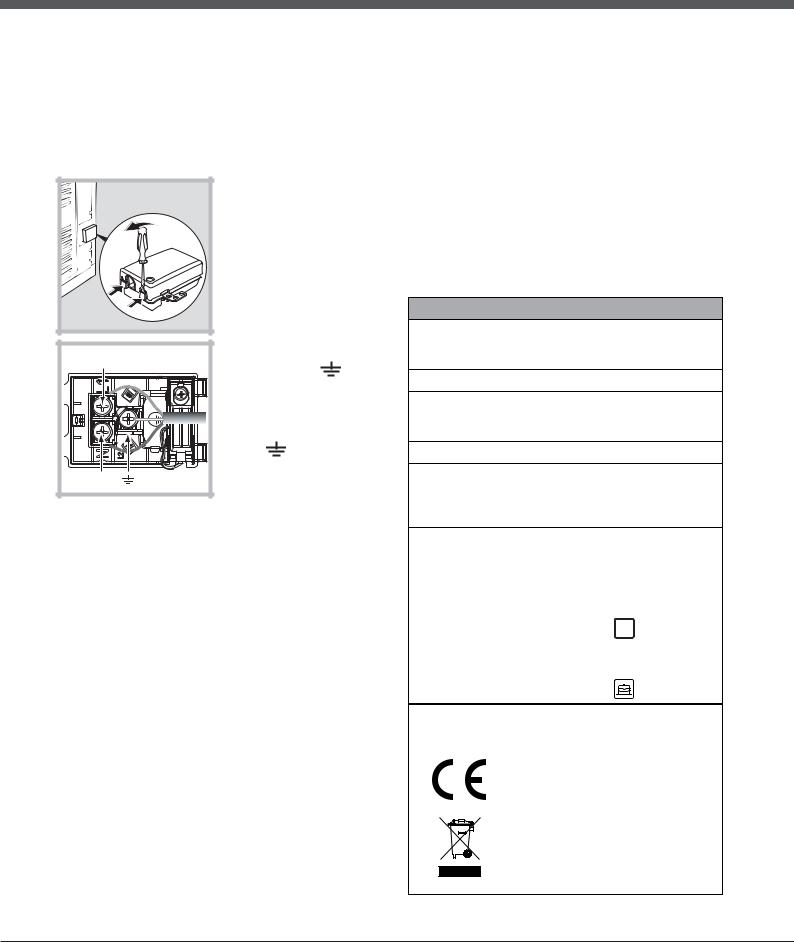
Collegamento elettrico
! I forni dotati di cavo di alimentazione tripolare sono predisposti per il funzionamento con corrente alternata, con tensione e frequenza indicate nella targhetta caratteristiche posta sull’apparecchio (vedi
sotto).
Montaggio del cavo di alimentazione
|
1. Aprire la morsettiera |
|||
|
facendo leva con un |
|
||
|
cacciavite sulle |
|
||
|
linguette laterali del |
|
||
|
coperchio: tirare e |
|
||
|
aprire il coperchio (vedi |
|||
|
figura). |
|
|
|
|
2. Mettere in opera il |
|||
|
cavo di alimentazione: |
|||
|
svitare la vite del |
|
||
L |
serracavo e le tre viti |
|||
dei contatti L-N- |
e |
|||
|
||||
|
poi fissare i cavetti |
|
||
|
sotto le teste delle viti |
|||
|
rispettando i colori Blu |
|||
|
(N) Marrone (L) Giallo- |
|||
|
Verde |
(vedi figura). |
||
|
3. Fissare il cavo |
|
||
N |
nell’apposito |
|
||
|
fermacavo. |
|
||
4. Chiudere il coperchio della morsettiera.
Allacciamento del cavo di alimentazione alla rete
Montare sul cavo una spina normalizzata per il carico indicato nella targhetta caratteristiche (vedi a
fianco).
In caso di collegamento diretto alla rete è necessario interporre tra l’apparecchio e la rete un interruttore onnipolare con apertura minima fra i contatti di 3 mm dimensionato al carico e rispondente alle norme in vigore (il filo di terra non deve essere interrotto dall’interruttore). Il cavo di alimentazione deve essere posizionato in modo tale che in nessun punto superi di 50°C la temperatura ambiente.
! L’installatore è responsabile del corretto collegamento elettrico e dell’osservanza delle norme di sicurezza.
Prima di effettuare l’allacciamento accertarsi che:
•la presa abbia la messa a terra e sia a norma di legge;
•la presa sia in grado di sopportare il carico massimo di potenza della macchina, indicato nella targhetta caratteristiche (vedi sotto);
• la tensione |
di alimentazione sia compresa nei |
|
|
IT |
|||
valori nella |
targhetta caratteristiche (vedi sotto); |
||
|
|
|
•la presa sia compatibile con la spina dell’apparecchio. In caso contrario sostituire la presa o la spina; non usare prolunghe e multiple.
!Ad apparecchio installato, il cavo elettrico e la presa della corrente devono essere facilmente raggiungibili.
!Il cavo non deve subire piegature o compressioni.
!Il cavo deve essere controllato periodicamente e sostituito solo da tecnici autorizzati (vedi Assistenza).
!L’azienda declina ogni responsabilità qualora queste norme non vengano rispettate.
TARGHETTA CARATTERISTICHE
Dimensioni |
larghezza cm 43,5 |
|
altezza cm 32 |
|
|
|
profondità cm 40 |
|
Volume |
lt. 56 |
|
Dimensioni * |
larghezza cm 43,5 |
|
altezza cm 32 |
|
|
|
profondità cm 41,5 |
|
Volume * |
lt. 58 |
|
Collegamenti |
tensione a 220-240V~ 50/60Hz |
|
potenza massima assorbita |
||
elettrici |
2800W (vedi targhetta |
|
|
caratteristiche) |
|
|
Direttiva 2002/40/CE |
|
|
sull’etichetta dei forni elettrici. |
|
|
Norma EN 50304 |
|
ENERGY |
Consumo energia convezione |
|
Naturale – funzione di |
||
LABEL |
riscaldamento: |
Tradizionale; |
|
Consumo energia dichiarazione |
|
|
Classe convezione Forzata - |
|
|
funzione di |
|
|
riscaldamento: |
Pasticceria. |
|
Questa apparecchiatura è |
|
|
conforme alle seguenti Direttive |
|
|
Comunitarie: 2006/95/CEE del |
|
|
12/12/06 (Bassa Tensione) e |
|
|
successive modificazioni - |
|
|
2004/108/CEE del 15/12/04 |
|
|
(Compatibilità Elettromagnetica) |
|
|
e successive modificazioni - |
|
|
93/68/CEE del 22/07/93 e |
|
|
successive modificazioni. |
|
|
2002/96/CE e successive |
|
|
modificazioni. |
|
|
1275/2008 stand-by/off mode |
|
* Con controporta in vetro
3
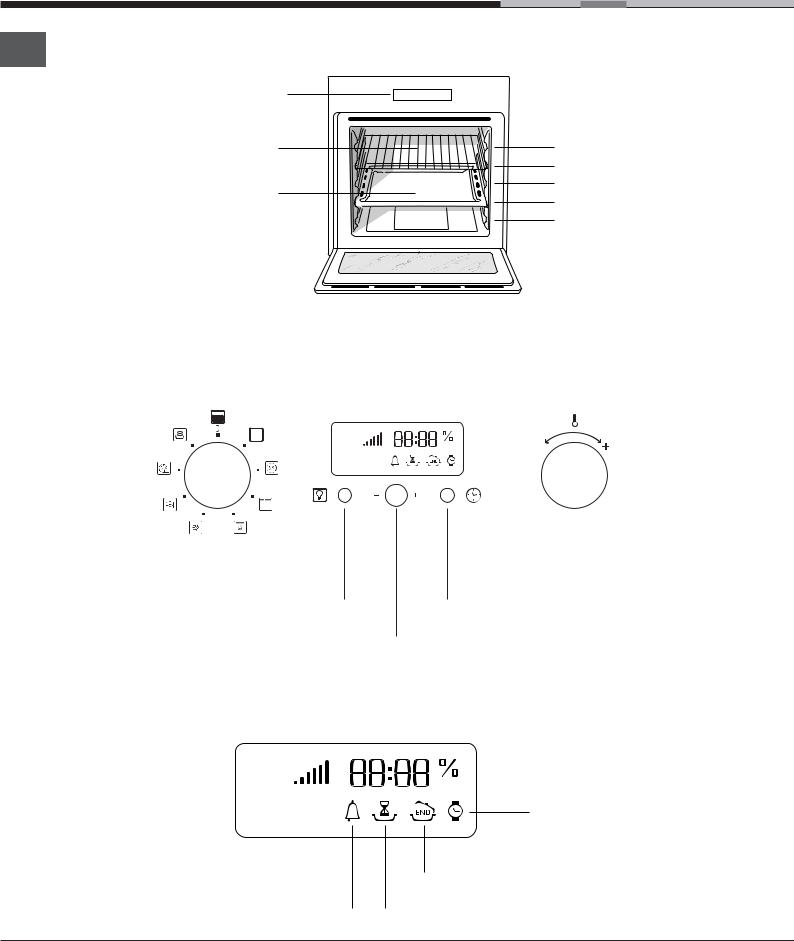
Descrizione dell’apparecchio
Vista d’insieme
IT
Pannello di controllo |
GUIDE di |
|
|
scorrimento dei |
|
|
ripiani |
|
Ripiano GRIGLIA |
posizione 5 |
|
|
posizione 4 |
|
Ripiano LECCARDA |
posizione 3 |
|
posizione 2 |
||
|
||
|
posizione 1 |
Pannello di controllo
|
Manopola |
DISPLAY |
|
|
Manopola |
|
|
PROGRAMMI |
|
|
|
TERMOSTATO |
|
|
|
|
|
|
|
|
|
|
|
|
|
|
|
|
|
|
|
|
|
|
|
|
|
|
|
|
|
Tasto |
Tasto |
LUCE |
IMPOSTAZIONE TEMPI |
|
Manopola |
|
IMPOSTAZIONE TEMPI |
Display
Indicatore del |
|
|
|
Digit numerici TEMPERATURA |
|
|
|||
Preriscaldamento |
|
|
|
e TEMPI |
|
|
|
|
|
Icona
OROLOGIO
Icona
FINE COTTURA
Icona Icona
CONTAMINUTI DURATA
4
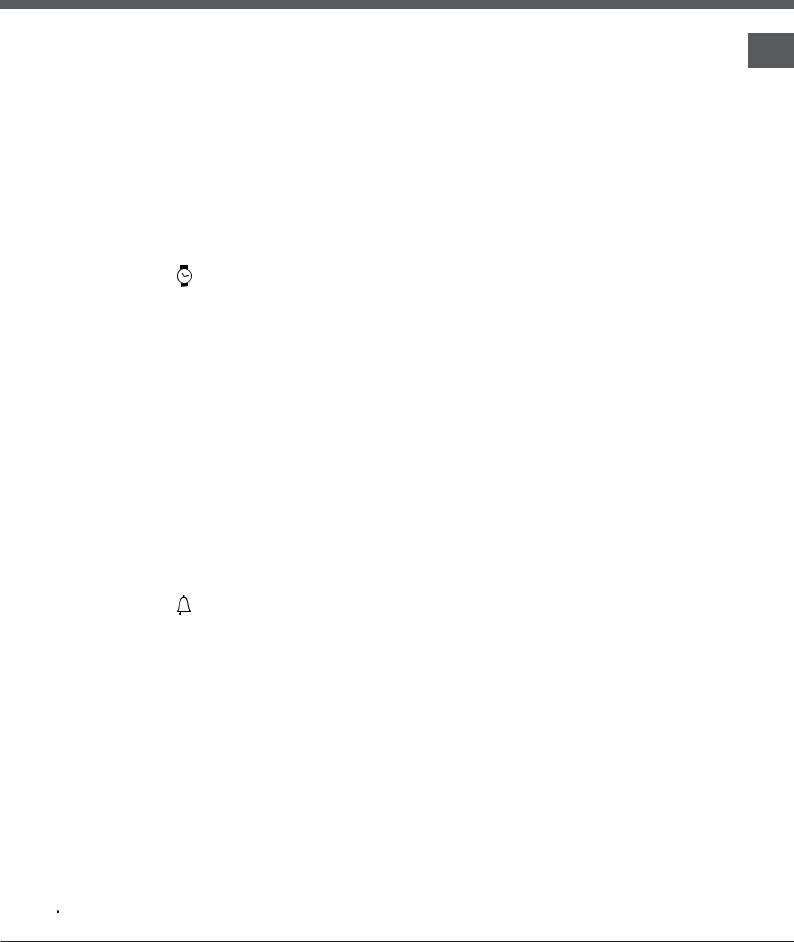
Avvio e utilizzo
! Alla prima accensione fare funzionare il forno a vuoto per almeno un’ora con il termostato al massimo e a porta chiusa. P oi spegnere, aprire la porta del forno e aerare il locale. L’odore che si avverte è dovuto all’evaporazione delle sostanze usate per proteggere il forno.
Impostare l’orologio
! Si può impostare sia quando il forno è spento che quando è acceso, ma non si è programmata la fine di una cottura.
1. Premere più volte il tasto  finchè non
finchè non
lampeggiano l’icona |
e i primi due digit numerici |
sul DISPLAY; |
|
2.ruotare la manopola IMPOSTAZIONE TEMPI verso il “+” e “-” per regolare l’ora;
3.premere di nuovo il tasto  finchè non lampeggiano gli altri due digit numerici sul DISPLAY;
finchè non lampeggiano gli altri due digit numerici sul DISPLAY;
4.ruotare la manopola IMPOSTAZIONE TEMPI verso il “+” e “-” per regolare i minuti;
5.premere nuovamente il tasto  per confermare.
per confermare.
Impostare il contaminuti
! Questa funzione non interrompe la cottura e prescinde dall’utilizzo del forno; permette solo di azionare il segnale acustico allo scadere dei minuti impostati.
1. Premere più volte il tasto  finchè non
finchè non
lampeggiano l’icona |
e i tre digit numerici sul |
DISPLAY; |
|
2.ruotare la manopola IMPOSTAZIONE TEMPI verso il “+” e “-” per regolare i minuti;
3.premere nuovamente il tasto  per confermare. Seguirà la visualizzazione del conto alla rovescia al termine del quale si azionerà il segnale acustico.
per confermare. Seguirà la visualizzazione del conto alla rovescia al termine del quale si azionerà il segnale acustico.
Avviare il forno
1.Selezionare il programma di cottura desiderato ruotando la manopola PROGRAMMI.
2.Il forno entra nella fase di preriscaldamento, l’indicatore del preriscaldamento si illumina.
È possibile modificare la temperatura ruotando la manopola TERMOSTATO.
3.Quando si spegne l’indicatore del preriscaldamento


 e si avverte un segnale acustico il
e si avverte un segnale acustico il
preriscaldamento è completo: introdurre gli alimenti. |
IT |
4. Durante la cottura è sempre possibile: |
-modificare il programma di cottura agendo sulla manopola PROGRAMMI;
-modificare la temperatura agendo sulla manopola TERMOSTATO;
-pianificare la durata e l’ora di fine della cottura
(vedi programmi di cottura);
- interrompere la cottura riportando la manopola PROGRAMMI in posizione “0”.
5. Trascorse due ore il forno si spegne automaticamente: tale tempo è preimpostato per motivi di sicurezza in tutti i programmi di cottura. È possibile modificare la durata della cottura
(vedi programmi di cottura).
6. In caso di black-out, se la temperatura del forno non si è abbassata troppo, l’apparecchio è dotato di un sistema che riattiva il programma dal punto in cui è stato interrotto. Le pianificazioni in attesa di avvio, invece, non vengono ripristinate al ritorno della corrente e devono essere riprogrammate.
!Nei programmi FAST COOKING e BARBECUE non è previsto il preriscaldamento.
!Non appoggiare mai oggetti sul fondo del forno perché si rischiano danni allo smalto.
!Porre sempre i recipienti di cottura sulla griglia in dotazione.
Ventilazione di raffreddamento
Per ottenere una riduzione delle temperature esterne, una ventola di raffreddamento genera un getto d’aria che esce tra il pannello di controllo e la porta del forno. Nel programma FAST COOKING la ventola si attiva automaticamente dopo dieci minuti dall’avvio. Nel programma PASTICCERIA si avvia solo a forno caldo.
! A fine cottura la ventola rimane attiva finché il forno non è sufficientemente freddo.
Luce del forno
A forno spento la lampadina può essere accesa in qualunque momento premendo il tasto .
.
5
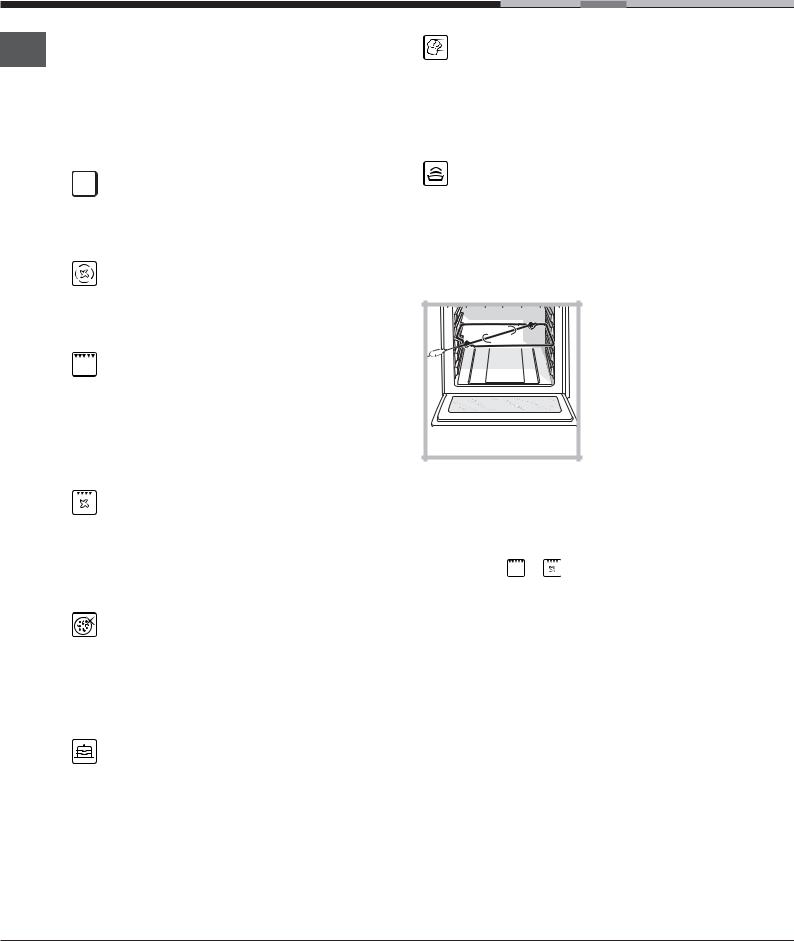
Programmi
Programmi di cottura
IT
! Tutti i programmi hanno una temperatura di cottura preimpostata. Essa può essere regolata manualmente, impostandola a piacere tra 40°C e 250°C.
Nel programma BARBECUE il valore preimpostato è un livello di potenza espresso in %. Anch’esso può essere regolato manualmente.
 Programma FORNO TRADIZIONALE
Programma FORNO TRADIZIONALE
Con questa cottura tradizionale è meglio utilizzare un solo ripiano: con più ripiani si ha una cattiva distribuzione della temperatura.
Programma MULTICOTTURA
Poiché il calore è costante in tutto il forno, l’aria cuoce e rosola il cibo in modo uniforme. È possibile utilizzare fino a un massimo di due ripiani contemporaneamente.
Programma BARBECUE
Ruotando la manopola TERMOSTATO, il display indicherà livelli di potenza impostabili, che vanno da 50% fino a 100%. La temperatura elevata e diretta del grill è consigliata per gli alimenti che necessitano di un’alta temperatura superficiale. Effettuare le cotture con la porta del forno chiusa.
Programma GRATIN
Unisce all’irradiazione termica unidirezionale la circolazione forzata dell’aria all’interno del forno.
Ciò impedisce la bruciatura superficiale degli alimenti aumentando il potere di penetrazione del calore. Effettuare le cotture con la porta del forno chiusa.
Programma FORNO PIZZA
Questa combinazione consente un rapido riscaldamento del forno, con un forte apporto di calore in prevalenza dal basso. Nel caso si utilizzi più di un ripiano alla volta, è necessario cambiarli di posizione tra loro a metà cottura.
Programma FORNO PASTICCERIA
Questo programma è indicato per la cottura dei cibi delicati (ad es. dolci che necessitano di lievitazione) e preparazioni “mignon” su tre ripiani contemporaneamente.
 Programma FAST COOKING
Programma FAST COOKING
Il programma non necessita di preriscaldamento. Questo programma è particolarmente indicato per cotture veloci di cibi preconfezionati (surgelati o precotti). I risultati migliori si ottengono utilizzando un solo ripiano.
Programma LIEVITAZIONE
Il forno raggiunge e mantiene una temperatura di 40°C a prescindere dalla posizione della manopola TERMOSTATO. Questo programma è ideale per la lievitazione degli impasti contenenti lievito naturale.
Girarrosto (solo in alcuni modelli)
Per azionare il girarrosto (vedi figura) procedere come segue:
1.mettere la leccarda in posizione 1;
2.mettere il sostegno del girarrosto in posizione 3 e inserire lo spiedo nell’apposito foro posto sulla parete posteriore del forno;
3.azionare il girarrosto selezionando con la manopola
PROGRAMMI o ;
6

Programmare la cottura
! La programmazione è possibile solo dopo aver selezionato un programma di cottura.
Programmare la durata di cottura
1. Premere più volte il tasto  finchè non
finchè non
lampeggiano l’icona |
e i tre digit numerici sul |
DISPLAY; |
|
2.ruotare la manopola IMPOSTAZIONE TEMPI verso il “+” e “-” per regolare il tempo desiderato;
3.premere nuovamente il tasto  per confermare;
per confermare;
4.a tempo scaduto, sul DISPLAY compare la scritta END, il forno termina la cottura e viene emesso un segnale acustico.
• Esempio: sono le 9:00 e viene programmata una durata di 1 ora e 15 minuti. Il programma si arresta automaticamente alle 10:15.
Programmare la fine di una cottura
! La programmazione della fine di una cottura è possibile solo dopo aver impostato una durata di cottura.
1.Seguire la procedura da 1 a 3 descritta per la durata;
2.poi premere il tasto  finchè non lampeggiano
finchè non lampeggiano
l’icona  e i due digit numerici sul DISPLAY;
e i due digit numerici sul DISPLAY;
3.ruotare la manopola IMPOSTAZIONE TEMPI verso il “+” e “-” per regolare l’ora;
4.premere di nuovo il tasto  finchè non lampeggiano gli altri due digit numerici sul DISPLAY;
finchè non lampeggiano gli altri due digit numerici sul DISPLAY;
5.ruotare la manopola IMPOSTAZIONE TEMPI verso il “+” e “-” per regolare i minuti;
6.premere nuovamente il tasto  per confermare;
per confermare;
7.a tempo scaduto, sul DISPLAY compare la scritta END, il forno termina la cottura e viene emesso un segnale acustico.
Le icone e  accese segnalano che è stata effettuata una programmazione. Sul DISPLAY vengono visualizzate alternativamente l’ora di fine cottura e la durata.
accese segnalano che è stata effettuata una programmazione. Sul DISPLAY vengono visualizzate alternativamente l’ora di fine cottura e la durata.
Per annullare una programmazione ruotare la manopola PROGRAMMI in posizione “0”.
Consigli pratici di cottura
IT
!Nelle cotture ventilate non utilizzare le posizioni 1 e 5: sono investite direttamente dall’aria calda che potrebbe provocare bruciature sui cibi delicati.
!Nelle cotture BARBECUE e GRATIN, in particolare se praticate col girarrosto, disporre la leccarda in posizione 1 per raccogliere i residui di cottura (sughi e/o grassi).
MULTICOTTURA
•Utilizzare le posizioni 2 e 4, mettendo alla 2 i cibi che richiedono maggior calore.
•Disporre la leccarda in basso e la griglia in alto. BARBECUE
•Inserire la griglia in posizione 3 o 4, disporre gli alimenti al centro della griglia.
•Si consiglia di impostare il livello di energia al massimo. Non allarmarsi se la resistenza superiore non resta costantemente accesa: il suo funzionamento è controllato da un termostato.
FORNO PIZZA
•Utilizzare una teglia in alluminio leggero, appoggiandola sulla griglia in dotazione.
Con la leccarda si allungano i tempi di cottura e difficilmente si ottiene una pizza croccante.
•Nel caso di pizze molto farcite è consigliabile inserire la mozzarella a metà cottura.
7

Tabella cottura
IT
Programmi |
Alimenti |
Peso |
Posizione |
Preriscaldamento |
Temperatura |
Durata |
||
|
|
(Kg) |
dei ripiani |
|
consigliata |
cottura |
||
|
|
|
|
|
|
|
(°C) |
(minuti) |
|
|
|
guide |
|
guide |
|
|
|
|
|
|
|
|
|
|
||
|
|
|
standard |
|
scorrevoli |
|
|
|
|
|
|
|
|
|
|
|
|
Forno |
Anatra |
1,5 |
2 |
|
1 |
si |
200-210 |
70-80 |
Tradizionale |
Pollo |
1,5 |
2 |
|
1 |
si |
200-210 |
60-70 |
|
Arrosto di vitello o manzo |
1 |
2 |
|
1 |
si |
200 |
70-75 |
|
Arrosto di maiale |
1 |
2 |
|
1 |
si |
200-210 |
70-80 |
|
Biscotti (di frolla) |
- |
2 |
|
1 |
si |
180 |
15-20 |
|
Crostate |
1 |
2 |
|
1 |
si |
180 |
30-35 |
|
|
|
|
|
|
|
|
|
Multicottura |
Pizza su 2 ripiani |
|
2 e 4 |
|
1 e 3 |
si |
220-230 |
20-25 |
|
Crostate su 2 ripiani/torte su 2 ripiani |
|
2 e 4 |
|
1 e 3 |
si |
180 |
30-35 |
|
Pan di spagna su 2 ripiani (su leccarda) |
|
2 e 4 |
|
1 e 3 |
si |
170 |
20-25 |
|
Pollo arrosto + patate |
1+1 |
1 e 2/3 |
|
1 e 3 |
si |
200-210 |
65-75 |
|
Agnello |
1 |
2 |
|
1 |
si |
190-200 |
45-50 |
|
Sgombro |
1 |
1 o 2 |
|
1 |
si |
180 |
30-35 |
|
Lasagne |
1 |
2 |
|
1 |
si |
190-200 |
35-40 |
|
Bignè su 2 ripiani |
|
2 e 4 |
|
1 e 3 |
si |
190 |
20-25 |
|
Biscotti su 2 ripiani |
|
2 e 4 |
|
1 e 3 |
si |
190 |
10-20 |
|
Salatini di sfoglia al formaggio su 2 ripiani |
|
2 e 4 |
|
1 e 3 |
si |
210 |
20-25 |
|
Torte salate |
|
1 e 3 |
|
1 e 3 |
si |
200 |
20-30 |
|
|
|
|
|
|
|
|
|
Barbecue |
Sgombri |
1 |
4 |
|
3 |
no |
100% |
15-20 |
|
Sogliole e seppie |
0,7 |
4 |
|
3 |
no |
100% |
10-15 |
|
Spiedini di calamari e gamberi |
0,7 |
4 |
|
3 |
no |
100% |
8-10 |
|
Filetto di merluzzo |
0,7 |
4 |
|
3 |
no |
100% |
10-15 |
|
Verdure alla griglia |
0,5 |
3 o 4 |
|
2 o 3 |
no |
100% |
15-20 |
|
Bistecca di vitello |
0,8 |
4 |
|
3 |
no |
100% |
15-20 |
|
Salsicce |
0,7 |
4 |
|
3 |
no |
100% |
15-20 |
|
Hamburger |
n° 4 o 5 |
4 |
|
3 |
no |
100% |
10-12 |
|
Toast (o pane tostato) |
n° 4 o 6 |
4 |
|
3 |
no |
100% |
3-5 |
|
Pollo allo spiedo con girarrosto (ove |
1 |
- |
|
- |
no |
100% |
70-80 |
|
presente) |
1 |
- |
|
- |
no |
100% |
70-80 |
|
Agnello allo spiedo con girarrosto (ove |
|
||||||
|
presente) |
|
|
|
|
|
|
|
|
|
|
|
|
|
|
|
|
Gratin |
Pollo alla griglia |
1,5 |
2 |
|
2 |
no |
210 |
55-60 |
|
Seppie |
1 |
2 |
|
2 |
no |
200 |
30-35 |
|
Pollo allo spiedo con girarrosto (ove |
1,5 |
- |
|
- |
no |
210 |
70-80 |
|
presente) |
1,5 |
- |
|
- |
no |
210 |
60-70 |
|
Anatra allo spiedo con girarrosto (ove |
|
||||||
|
presente) |
1 |
2 |
|
2 |
no |
210 |
60-75 |
|
Arrosto di vitello o manzo |
|
||||||
|
Arrosto di maiale |
1 |
2 |
|
2 |
no |
210 |
70-80 |
|
Agnello |
1 |
2 |
|
2 |
no |
210 |
40-45 |
|
|
|
|
|
|
|
|
|
Forno Pizza |
Pizza |
0,5 |
2 |
|
1 |
si |
220 |
15-20 |
|
Focacce |
0,5 |
2 |
|
1 |
si |
200 |
20-25 |
|
|
|
|
|
|
|
|
|
Forno |
Crostate |
0,5 |
2 o 3 |
|
1 o 2 |
si |
180 |
25-35 |
Pasticceria |
Torta di frutta |
1 |
2 o 3 |
|
1 o 2 |
si |
180 |
40-50 |
|
Plum-cake |
0,7 |
2 o 3 |
|
1 o 2 |
si |
170-180 |
45-55 |
|
Cake piccoli su 2 ripiani |
0,7 |
2 e 4 |
|
1 e 3 |
si |
180-190 |
20-25 |
|
Pan di spagna |
0,6 |
2 o 3 |
|
1 o 2 |
si |
160-170 |
30-40 |
|
Bignè su 3 ripiani |
0,7 |
1 e 3 e 5 |
|
1 e 2 e 4 |
si |
180-190 |
20-25 |
|
Biscotti su 3 ripiani |
0,7 |
1 e 3 e 5 |
|
1 e 2 e 4 |
si |
180 |
20-25 |
|
Crêpes farcite |
0,8 |
2 |
|
1 |
si |
200 |
30-35 |
|
Meringhe su 3 ripiani |
0,5 |
1 e 3 e 5 |
|
1 e 2 e 4 |
si |
90 |
180 |
|
Salatini di sfoglia al formaggio |
0,5 |
2 |
|
1 |
si |
210 |
20-25 |
|
|
|
|
|
|
|
|
|
Fast cooking |
Surgelati |
|
|
|
|
|
|
|
|
Pizza |
0.3 |
2 |
|
1 |
- |
250 |
12 |
|
Misto zucchine e gamberi in pastella |
0.4 |
2 |
|
1 |
- |
200 |
20 |
|
Torta rustica di spinaci |
0.5 |
2 |
|
1 |
- |
220 |
30-35 |
|
Panzerotti |
0.3 |
2 |
|
1 |
- |
200 |
25 |
|
Lasagne |
0.5 |
2 |
|
1 |
- |
200 |
35 |
|
Panetti dorati |
0.4 |
2 |
|
1 |
- |
180 |
25-30 |
|
Bocconcini di pollo |
0.4 |
2 |
|
1 |
- |
220 |
15-20 |
|
|
|
|
|
|
|
|
|
|
Precotti |
|
|
|
|
|
|
|
|
Ali di pollo dorate |
0.4 |
2 |
|
1 |
- |
200 |
20-25 |
|
|
|
|
|
|
|
|
|
|
Cibi Freschi |
|
|
|
|
|
|
|
|
Biscotti (di frolla) |
0.3 |
2 |
|
1 |
- |
200 |
15-18 |
|
Plum-cake |
0.6 |
2 |
|
1 |
- |
180 |
45 |
|
Salatini di sfoglia al formaggio |
0.2 |
2 |
|
1 |
- |
210 |
10-12 |
|
|
|
|
|
|
|
|
|
Lievitazione |
Lievitazione degli impasti con lievito |
|
2 |
|
1 |
|
40 |
30-60 |
|
naturale (brioche, pane, torta allo zucchero, |
|
|
|
|
|
|
|
|
croissant, ecc.) |
|
|
|
|
|
|
|
|
|
|
|
|
|
|
|
|
! I tempi di cottura sono indicativi e possono essere modificati in base ai proprio gusti personali. I tempi di preriscaldamento del forno sono preimpostati e non modificabili manualmente.
8

Precauzioni e consigli
! L’apparecchio è stato progettato e costruito in conformità alle norme internazionali di sicurezza. Queste avvertenze sono fornite per ragioni di sicurezza e devono essere lette attentamente.
Sicurezza generale
•L’apparecchio è stato concepito per un uso di tipo non professionale all’interno dell’abitazione.
•L’apparecchio non va installato all’aperto, nemmeno se lo spazio è riparato, perché è molto pericoloso lasciarlo esposto a pioggia e temporali.
•Per movimentare l’apparecchio servirsi sempre delle apposite maniglie poste sui fianchi del forno.
•Non toccare la macchina a piedi nudi o le mani o i piedi bagnati o umidi.
•L’apparecchio deve essere usato per cuocere alimenti, solo da persone adulte e secondo le istruzioni riportate in questo libretto. Ogni altro uso (ad esempio: riscaldamento di ambienti) è da considerarsi improprio e quindi pericoloso. Il costruttore non può essere considerato responsabile per eventuali danni derivanti da usi impropri, erronei ed irragionevoli.
•Durante l'uso dell'apparecchio gli elementi riscaldanti e alcune parti della porta forno diventano molto calde. Fare attenzione a non toccarle e tenere i bambimi a distanza.
•Evitare che il cavo di alimentazione di altri elettrodomestici entri in contatto con parti calde del forno.
•Non ostruire le aperture di ventilazione e di smaltimento di calore.
•Impugnare la maniglia di apertura della porta al centro: ai lati potrebbe essere calda.
•Utilizzare sempre guanti da forno per inserire o estrarre recipienti.
•Non rivestire il fondo del forno con fogli di alluminio.
•Non riporre materiale infiammabile nel forno: se l’apparecchio viene messo inavvertitamente in funzione potrebbe incendiarsi.
•Assicurarsi sempre che le manopole siano nella posizione “”/“” quando l’apparecchio non è utilizzato.
•Non staccare la spina dalla presa della corrente tirando il cavo, bensì afferrando la spina.
•Non fare pulizia o manutenzione senza aver prima staccato la spina dalla rete elettrica.
•In caso di guasto, in nessun caso accedere ai meccanismi interni per tentare una riparazione. Contattare l’Assistenza (vedi Assistenza).
•Non appoggiare oggetti pesanti sulla porta del forno aperta.
• Non è previsto che l'apparecchio venga utilizzato da |
|
|
IT |
||
persone (bambini compresi) con ridotte capacità |
||
fisiche, sensoriali o mentali, da persone inesperte o |
|
|
|
||
che non abbiano familiarità con il prodotto, a meno che |
|
|
non vengano sorvegliate da una persona responsabile |
|
|
della loro sicurezza o non abbiano ricevuto istruzioni |
|
|
preliminari sull'uso dell'apparecchio. |
|
|
• Evitare che i bambini giochino con l'apparecchio. |
|
Smaltimento
•Smaltimento del materiale di imballaggio: attenersi alle norme locali, così gli imballaggi potranno essere riutilizzati.
•La direttiva Europea 2002/96/CE sui rifiuti di apparecchiature elettriche ed elettroniche (RAEE), prevede che gli elettrodomestici non debbano essere smaltiti nel normale flusso dei rifiuti solidi urbani. Gli apparecchi dismessi devono essere raccolti separatamente per ottimizzare il tasso di recupero e riciclaggio dei materiali che li compongono ed impedire potenziali danni per la salute e l’ambiente. Il simbolo del cestino barrato è riportato su tutti i prodotti per ricordare gli obblighi di raccolta separata.
Per ulteriori informazioni, sulla corretta dismissione degli elettrodomestici, i detentori potranno rivolgersi al servizio pubblico preposto o ai rivenditori.
Risparmiare e rispettare l’ambiente
•Azionando il forno negli orari che vanno dal tardo pomeriggio fino alle prime ore del mattino si collabora a ridurre il carico di assorbimento delle aziende elettriche. Le opzioni di pianificazione dei programmi, in particolar modo la “cottura ritardata” (vedi Programmi) e la “pulizia automatica ritardata” (vedi Manutenzione e cura), permettono di organizzarsi in tal senso.
•Si raccomanda di effettuare sempre le cotture al BARBECUE e GRATIN a porta chiusa: sia per ottenere migliori risultati che per un sensibile risparmio di energia (10% circa).
•Mantenere efficienti e pulite le guarnizioni, in modo che aderiscano bene alla porta e non procurino dispersioni di calore.
! Questo prodotto soddisfa i requisiti imposti dalla nuova Direttiva Europea sulla limitazione dei consumi energetici in standby.
Se non si eseguono operazioni per 2 minuti, l’apparecchio si dispone automaticamente in modalità standby.
La modalità standby è visualizzata con “Icona Orologio” in alta luminosità.
Non appena si interagisce nuovamente con l’apparecchio, il sistema ritorna in modalità operativa.
9
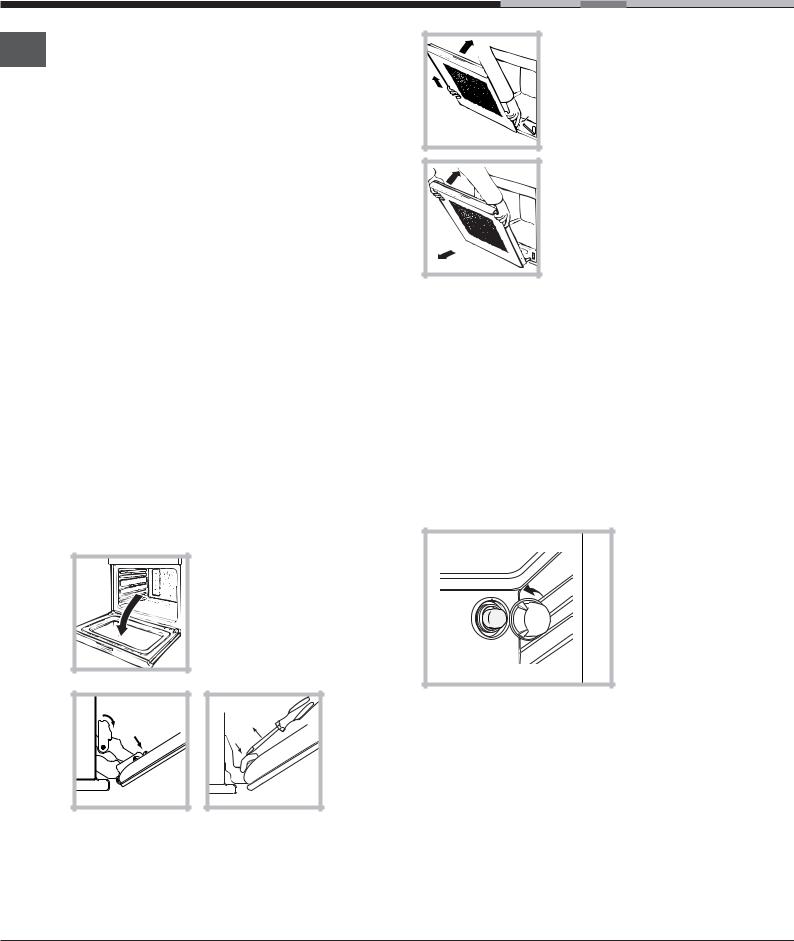
Manutenzione e cura
Escludere la corrente elettrica
IT
Prima di ogni operazione isolare l’apparecchio dalla rete di alimentazione elettrica.
Pulire l’apparecchio
•Le parti esterne smaltate o inox e le guarnizioni in gomma possono essere pulite con una spugnetta imbevuta di acqua tiepida, e sapone neutro. Se le macchie sono difficili da asportare usare prodotti specifici. Si consiglia di sciacquare abbondantemente e di asciugare dopo la pulizia. Non usare polveri abrasive o sostanze corrosive.
•L’interno del forno va pulito preferibilmente ogni volta dopo l’uso, quando è ancora tiepido. Usare acqua calda e detersivo, risciaquare e asciugare con un panno morbido. Evitare gli abrasivi.
•Gli accessori possono essere lavati come normali stoviglie, anche in lavastoviglie ad eccezione delle guide scorrevoli.
! Non utilizzare mai pulitori a vapore o ad alta pressione per la pulizia dell’apparecchio.
Pulire la porta
Pulire il vetro della porta con spugne e prodotti non abrasivi e asciugare con un panno morbido; non usare materiali ruvidi abrasivi o raschietti metallici affilati che possono graffiare la superficie e causare la frantumazione del vetro.
Per una pulizia più accurata è possibile smontare
la porta del forno:
1. aprire completamente la
porta (vedi figura);
2. servendosi di un cacciavite,
alzare e ruotare le levette F poste sulle due cerniere (vedi
figura);
F |
F |
* Presente solo in alcuni modelli.
F |
3. afferrare la porta ai due lati esterni, richiudendola lentamente ma non del tutto. Premere i fermi F, poi tirare la porta verso di sé estraendola dalle cerniere (vedi figura).*
3. afferrare la porta ai due lati esterni, richiudendola lentamente ma non del tutto. Poi tirare la porta verso di sé estraendola dalle cerniere
(vedi figura).*
Rimontare la porta seguendo il procedimento in senso contrario.
Controllare le guarnizioni
Controllare periodicamente lo stato della guarnizione attorno alla porta del forno. In caso risulti danneggiata rivolgersi al Centro Assistenza più vicino (vedi Assistenza). È consigliabile non usare il forno
fino all’avvenuta riparazione.
Sostituire la lampadina
Per sostituire la lampadina di illuminazione del forno:
1.Svitare il coperchio in vetro del portalampada.
2.Svitare la lampadina e sostituirla con una analoga: potenza 25 W, attacco E 14.
3.Rimontare il coperchio (vedi figura).
10
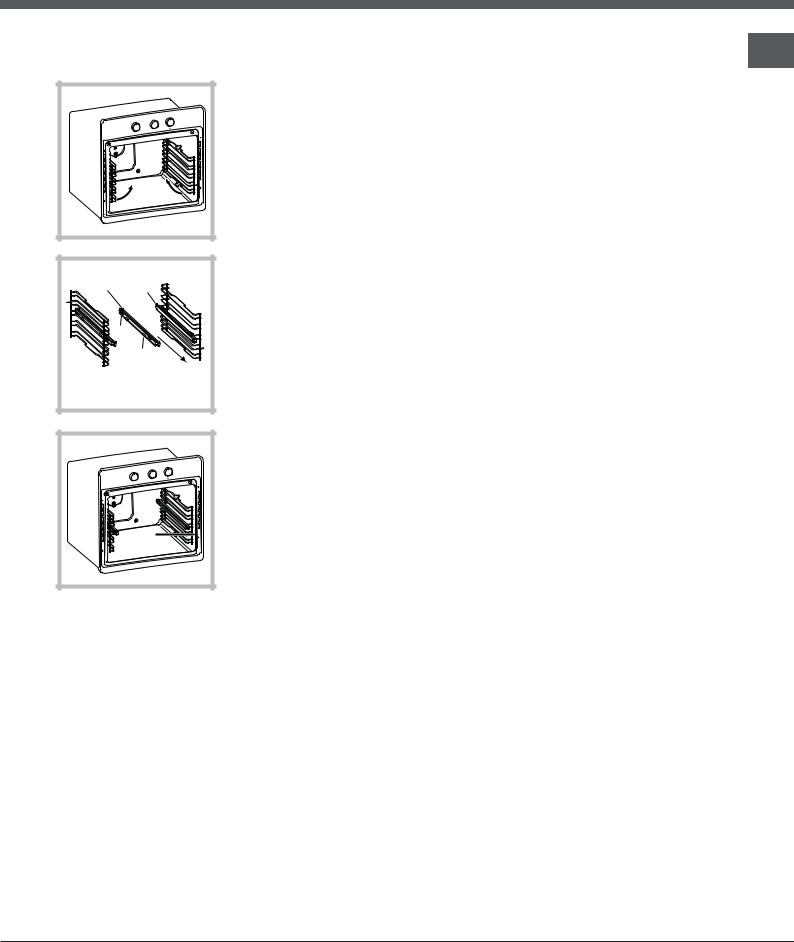
Montaggio del Kit Guide Scorrevoli
Per montare le guide scorrevoli: IT
A |
1. Togliere i due telai estraendoli dai distanzieri A (vedi
figura).
Guida |
Guida |
|
sinistra |
destra |
|
|
B |
|
|
C |
Verso |
|
|
|
|
|
di |
|
|
estrazione |
2. Scegliere il ripiano in cui inserire la guida scorrevole. Facendo attenzione al verso di estrazione della guida stessa, posizionare sul telaio prima l’incastro B e poi l’incastro C.
D |
3. Fissare i due telai con le guide montate negli appositi fori posti sulle pareti del forno (vedi figura). I fori per il telaio sinistro sono posizionati in alto, mentre i fori per quello destro sono in basso.
4. Infine incastrare i telai sui distanzieri A.
! Non inserire le guide scorrevoli alla posizione 5.
11

Assistenza
Attenzione:
IT |
L’apparecchio è dotato di un sistema di diagnostica automatica che consente di rilevare eventuali |
|
|
||
|
malfunzionamenti. Questi vengono comunicati dal display tramite messaggi del tipo: “F” seguito da numeri. |
|
|
In questi casi è necessario l’intervento dell’assistenza tecnica. |
|
|
! Non ricorrere mai a tecnici non autorizzati. |
|
|
Comunicare: |
|
|
• |
Il tipo di anomalia; |
|
• |
Il modello della macchina (Mod.) |
|
• |
Il numero di serie (S/N) |
Queste ultime informazioni si trovano sulla targhetta caratteristiche posta sull’apparecchio
Assistenza attiva 7 giorni su 7 
In caso di necessità d’intervento chiamare il Numero Unico Nazionale 199.199.199*.
Un operatore sarà a completa disposizione per fissare un appuntamento con il Centro Assistenza Tecnico Autorizzato più vicino al luogo da cui si chiama.
È attivo 7 giorni su 7, sabato e domenica compresi, e non lascia mai inascoltata una richiesta.
*Al costo di 14,26 centesimi di Euro al minuto(iva inclusa) dal Lun. al Ven. dalle 08:00 alle 18:30, il Sab. dalle 08:00 alle 13:00 e di 5,58 centesimi di Euro al minuto (iva inclusa) dal Lun. al Ven. dalle 18:30 alle 08:00, il Sab. dalle 13:00 alle 08:00 e i giorni festivi, per chi chiama da telefono fisso.
Per chi chiama da radiomobile le tariffe sono legate al piano tariffario dell’operatore telefonico utilizzato.
Le suddette tariffe potrebbero essere soggette a variazione da parte dell’operatore telefonico; per maggiori informazioni consultare il sito www.aristonchannel.com.
12

Operating Instructions
OVEN
|
|
|
|
|
|
|
|
|
|
|
|
|
|
|
|
Contents |
|
|
|
|
|
|
|
|
GB |
|
|
|
|
|
|
|
|
|
|
|
|
|
|
|
|
|
Installation, 14-15 |
|
|
IT |
|
GB |
|
FR |
|
|
|
|
|
|
|
Positioning |
||||
|
|
|
|
|
|
|
Electrical connection |
|
|
|
|
|
|
|
|
||
|
Italiano, 1 |
English, 13 |
Français, 25 |
Technical data |
||||
|
|
|
|
|
|
|
Description of the appliance, 16 |
|
|
ES |
|
PT |
|
RS |
|
||
|
|
|
|
Overall view |
||||
|
|
|
|
|
|
|
Control panel |
|
|
Espanol, 37 |
Portuges, 49 |
, 61 |
|||||
|
Display |
|||||||
|
|
|
|
|
|
|
Start-up and use, 17 |
|
|
|
|
|
|
|
|
Setting the clock |
|
|
|
|
|
|
|
|
Setting the timer |
|
|
|
|
|
|
|
|
Starting the oven |
|
|
|
|
|
|
|
|
Cooking modes, 18-20 |
|
|
FZ 990 C.1 /HA |
|
|
Cooking modes |
||||
|
|
|
Programming cooking |
|||||
|
FZ 990 C.1 IX /HA |
|
|
Practical cooking advice |
||||
|
FZ 99 C.1 /HA |
|
|
Cooking advice table |
||||
|
FZ 99 C.1 IX /HA |
|
|
|
|
|||
|
FQ 99 C.1 /HA |
|
|
Precautions and tips, 21 |
||||
|
FZ 992 C.1 /HA |
|
|
General safety |
||||
|
FZ 992 C.1 IX /HA |
|
|
Disposal |
||||
|
FB 99 C.1 /HA |
|
|
Respecting and conserving the environment |
||||
|
FB 99 C. 1 IX /HA |
|
|
|
|
|||
|
FD 99 C.1/HA |
|
|
Care and maintenance, 22-23 |
||||
|
F 99 C.1 /HA |
|
|
Switching the appliance off |
||||
|
F 99 C.1 IX /HA |
|
|
Cleaning the appliance |
||||
|
F 89.1/HA |
|
|
|
|
Cleaning the oven door |
||
|
F 89.1 IX/HA |
|
|
Replacing the light bulb |
||||
|
FH 99 C /HA |
|
|
Assembling the sliding rack kit |
||||
|
FH 99 C IX /HA |
|
|
|
|
|||
|
FH 997 C IX/HA |
|
|
Assistance, 24 |
||||
|
FH 997 C /HA |
|
|
|
|
|||
|
FH 899 XA/HA |
|
|
|
|
|||
|
FH 899C XA/HA |
|
|
|
|
|||
13
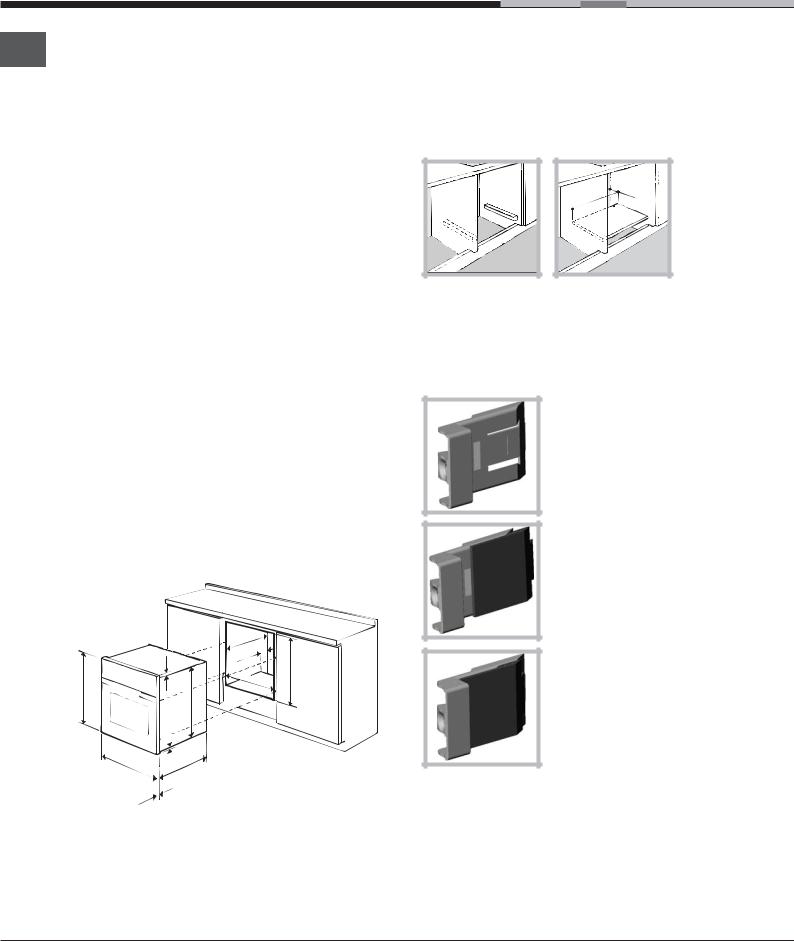
Installation
! Before operating your new appliance please read GB this instruction booklet carefully. It contains
important information concerning the safe operation, installation and maintenance of the appliance.
! Please keep these operating instructions for future reference. Pass them on to possible new owners of the appliance.
Positioning
! Keep packaging material out of the reach of children.
It can become a choking or suffocation hazard. (see Precautions and tips).
! The appliance must be installed by a qualified professional in accordance with the instructions provided. Incorrect installation may cause harm to people and animals or may damage property.
Built-in appliance
Use the appropriate cabinet to ensure that the appliance functions properly.
•The panels adjacent to the oven must be made of heat-resistant material.
•Cabinets with a veneer exterior must be assembled with glues which can withstand temperatures of up to 100°C.
•to install the oven under the counter (see diagram) or in a kitchen unit, the cabinet must have the following dimensions:
|
|
|
. |
|
23 mm. |
|
.min |
|
|
mm |
|
mm.595 |
mm.567 |
547 |
|
585-575mm. |
|||
|
|
|
. |
|
|
|
mm |
|
|
|
45 |
|
|
560 |
mm. |
|
|
|
|
595 |
|
5 mm. |
|
mm. |
. |
|
|
|
mm |
|
|
|
|
545 |
|
|
. |
|
|
|
mm |
|
|
24 |
|
|
|
! The appliance must not come into contact with electrical parts once it has been installed.
The indications for consumption given on the data plate have been calculated for this type of installation.
Ventilation
To ensure adequate ventilation is provided, the back panel of the cabinet must be removed. It is advisable to install the oven so that it rests on two strips of wood, or on a completely flat surface with an opening of at least 45 x 560 mm (see diagrams).
. |
45 |
m |
|
mm |
|
m |
. |
560 |
|
|
|
Centring and fixing
Position the 4 tabs on the side of the oven, in line with the 4 holes on the outer frame. Adjust the tabs according to the thickness of the cabinet side panel, as shown below:
20 mm thick: take off the removable part of the tab
(see diagram).
18 mm thick: use the first groove, which has already been set in the factory
(see diagram).
16 mm thick: use the second groove (see diagram).
Secure the appliance to the cabinet by opening the oven door and inserting 4 screws into the 4 holes on the outer frame.
! All parts which ensure the safe operation of the appliance must not be removable without the aid of a tool.
14
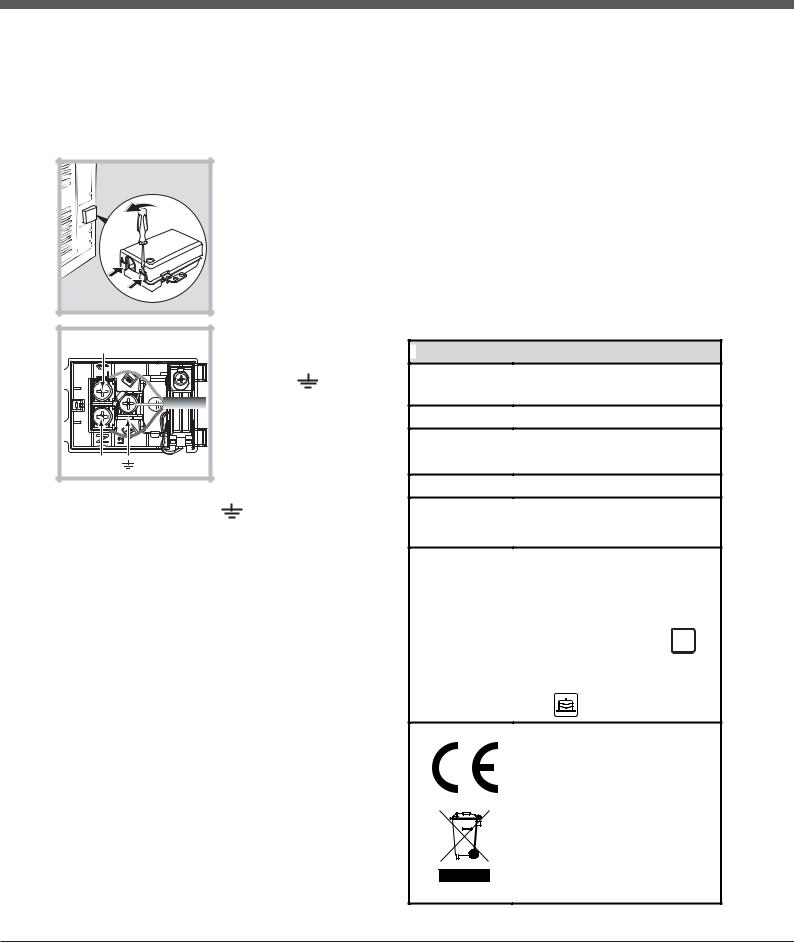
Electrical connection
! Ovens equipped with a three-pole power supply cable are designed to operate with alternating current at the voltage and frequency indicated on the data plate located on the appliance (see below).
Fitting the power supply cable
|
1. Open the terminal |
|
board by inserting a |
|
screwdriver into the |
|
side tabs of the cover. |
|
Use the screwdriver as |
|
a lever by pushing it |
|
down to open the cover |
|
(see diagram). |
|
2. Install the power |
|
supply cable by |
L |
loosening the cable |
clamp screw and the |
|
|
three wire contact |
|
screws L-N- . |
|
Connect the wires to the |
|
corresponding |
|
terminals: the Blue wire |
|
to the terminal marked |
N |
(N), the Brown wire to |
|
the terminal marked (L) |
|
and the Yellow/Green |
wire to the terminal marked |
(see diagram). |
3.Secure the cable by fastening the clamp screw.
4.Close the cover of the terminal board.
Connecting the electricity supply cable to the mains
Install a standardised plug corresponding to the load indicated on the data plate (see table).
The appliance must be directly connected to the mains using an omnipolar switch with a minimum contact opening of 3 mm installed between the appliance and the mains. The switch must be suitable for the charge indicated and must comply with current electrical regulations (the earthing wire must not be interrupted by the switch). The supply cable must be positioned so that it does not come into contact with temperatures higher than 50°C at any point.
! The installer must ensure that the correct electrical connection has been made and that it is fully compliant with safety regulations.
Before connecting the appliance to the power supply, make sure that:
•The appliance is earthed and the plug is compliant with the law.
• The socket can withstand the maximum power of |
|
|
GB |
||
the appliance, which is indicated on the data |
||
plate (see below). |
|
|
|
•The voltage is in the range between the values indicated on the data plate (see below).
•The socket is compatible with the plug of the appliance. If the socket is incompatible with the plug, ask an authorised technician to replace it. Do not use extension cords or multiple sockets.
!Once the appliance has been installed, the power supply cable and the electrical socket must be easily accessible.
!The cable must not be bent or compressed.
!The cable must be checked regularly and replaced by authorised technicians only (see Assistance).
!The manufacturer declines any liability should these safety measures not be observed.
 TABLE OF CHARACTERISTICS
TABLE OF CHARACTERISTICS
width 43.5 cm
Dimensions height 32 cm depth 40 cm
Volume |
56 l |
width 43.5 cm
Dimensions * height 32 cm depth 41.5 cm
Volume * |
58 l |
Electrical
voltage: 220 - 240 V~ 50/60Hz
connections
maximum power absorbed 2800 W (see data plate)
|
Directive 2002/40/EC on the label of |
|
|
electric ovens. Standard EN 50304 |
|
ENERGY |
Energy consumption for Natural |
|
convection – heating mode: |
||
LABEL |
Traditional mode |
|
|
Declared energy consumption for |
|
|
Forced convection Class – heating |
|
|
mode: |
Baking |
|
This appliance conforms to the |
|
|
following European Economic |
|
|
Community directives: 2006/95/EEC |
|
|
dated 12/12/06 (Low Voltage) and |
|
|
subsequent amendments – |
|
|
2004/108/EEC dated 15/12/04 |
|
|
(Electromagnetic Compatibility) and |
|
|
subsequent amendments - |
|
|
93/68/EEC dated 22/07/93 and |
|
|
subsequent amendments. |
|
|
2002/96/EC and subsequent |
|
|
amendments. |
|
|
1275/2008 stand-by/off mode |
|
* With glass panel fitted to the inside of the door
15
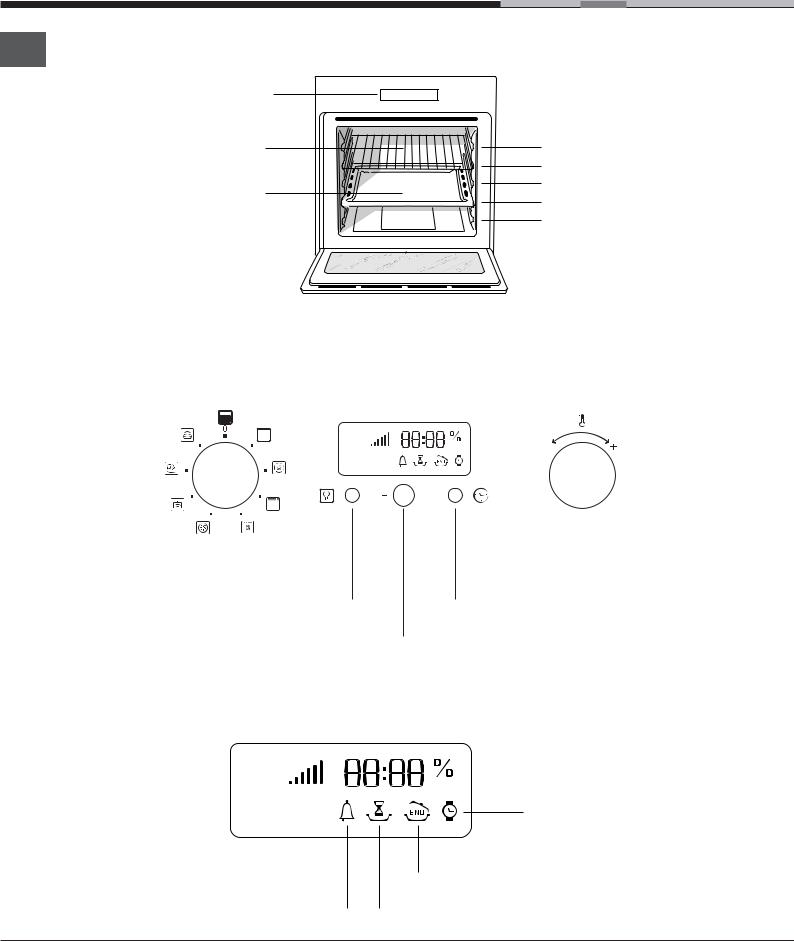
Description
of the appliance
Overall view
GB
Control panel |
GUIDES for the |
|
|
sliding racks |
|
GRILL |
position 5 |
|
|
position 4 |
|
DRIPPING PAN |
position 3 |
|
position 2 |
||
|
||
|
position 1 |
Control panel
|
SELECTOR |
DISPLAY |
|
|
THERMOSTAT |
|
|
Knob |
|
|
|
knob |
|
|
|
|
|
|
|
|
|
|
|
|
|
|
|
|
|
|
|
|
|
|
|
|
|
|
|
|
|
LIGHT |
TIME SETTING |
button |
button |
|
TIMER |
|
knob |
Display
Preheating |
|
TEMPERATURE |
indicator |
|
and TIME digits |
|
|
|
CLOCK icon
END OF COOKING icon
TIMER DURATION icon icon
16

Start-up and use
! The first time you use your appliance, heat the empty oven with its door closed at its maximum temperature for at least half an hour. Ensure that the room is well ventilated before switching the oven off and opening the oven door. The appliance may emit a slightly unpleasant odour caused by protective substances used during the manufacturing process burning away.
Setting the clock
! The clock may be set when the oven is switched off or when it is switched on, provided that a the end time of a cooking cycle has not been programmed previously.
1.Press the  button several times until the
button several times until the  icon and the first two digits on the display start to flash.
icon and the first two digits on the display start to flash.
2.Turn the TIMER KNOB towards “+” and “-” to adjust the hour value.
3.Press the  button again until the other two digits on the DISPLAY begin to flash.
button again until the other two digits on the DISPLAY begin to flash.
4.Turn the TIMER KNOB towards “+” and “-” to adjust the minute value.
5.Press the  button again to confirm.
button again to confirm.
Setting the timer
! This function does not interrupt cooking and does not affect the oven; it is simply used to activate the buzzer when the set amount of time has elapsed.
1.Press the  button several times until the
button several times until the  icon and the three digits on the display begin to flash.
icon and the three digits on the display begin to flash.
2.Turn the TIMER KNOB towards “+” and “-” to adjust the minute value.
3.Press the  button again to confirm.
button again to confirm.
The display will then show the time as it counts down. When this period of time has elapsed the buzzer will be activated.
Starting the oven
1.Select the desired cooking mode by turning the SELECTOR knob.
2.The oven begins its preheating stage and the preheating indicator lights up.
The temperature may be changed by turning the THERMOSTAT knob
3. |
When the preheating indicator |
switches off |
GB |
|
and a buzzer sounds the preheating process is |
||||
|
||||
complete: you may now place the food in the oven. |
|
|||
4. |
During cooking it is always possible to: |
|
||
-change the cooking mode by turning the SELECTOR knob
-change the temperature by turning the THERMOSTAT knob
-set the cooking duration in addition to the cooking end time
(see Cooking modes)
- stop cooking by turning the SELECTOR knob to the “0” position.
5. The oven switches off automatically after two hours: this default period of time is set for all cooking modes for safety reasons.
The cooking duration may be changed
(see Cooking modes).
6. If a blackout occurs while the oven is already in operation, an automatic system within the appliance will reactivate the cooking mode from where it was interrupted as long as the temperature has not dropped below a certain level. Programmed cooking modes which have not started will not be restored and must be reprogrammed.
!There is no preheating stage for the FAST COOKING and BARBECUE modes.
!Never put objects directly on the bottom of the oven; this will avoid the enamel coating being damaged.
!Always place cookware on the rack(s) provided.
Cooling ventilation
In order to cool down the external temperature of the oven, a cooling fan blows a stream of air between the control panel and the oven door. In the FAST COOKING mode, the fan is activated automatically after ten minutes. In the BAKING mode, the cooling fan is only activated when the oven is hot.
! Once cooking has been completed, the cooling fan continues to operate until the oven has cooled down sufficiently.
Oven light
When the oven is not in operation, the lamp can be switched on at any time by pressing the button  .
.
17

Cooking modes
Cooking modes
GB
! All cooking modes have a default cooking temperature which may be adjusted manually between 40°C and 250°C as desired.
In the BARBECUE mode, the default power level value is indicated as a percentage (%) and may also be adjusted manually.
 TRADITIONAL OVEN mode
TRADITIONAL OVEN mode
When using this traditional cooking mode, it is best to use one cooking rack only. if more than one rack is used, the heat will be distributed unevenly.
MULTI-COOKING mode
Since the heat remains constant throughout the oven, the air cooks and browns food in a uniform manner. A maximum of two racks may be used at the same time.
BARBECUE mode
By turning the THERMOSTAT knob, the different power levels which may be set will appear on the display; these range between 50% and 100%. The high and direct temperature of the grill is recommended for food which requires a high surface temperature. Always cook in this mode with the oven door closed.
GRATIN mode
This combination of features increases the effectiveness of the unidirectional thermal radiation provided by the heating elements through forced circulation of the air throughout the oven.
This helps prevent food from burning on the surface and allows the heat to penetrate right into the food. Always cook in this mode with the oven door closed.
 PIZZA OVEN mode
PIZZA OVEN mode
This combination heats the oven rapidly by producing a considerable amount of heat, particularly from the element at the bottom. If you use more than one rack at a time, switch the position of the dishes halfway through the cooking process.
BAKING mode
This mode is ideal for baking temperature sensitive foods (such as cakes, which need to rise) and for the preparation of “bitesize pastries” on 3 shelves simultaneously.
 FAST COOKING mode
FAST COOKING mode
Preheating is not necessary for this cooking mode. This mode is particularly suitable for cooking prepacked food quickly (frozen or pre-cooked). The best results are achieved using one cooking rack only.
PROVING mode
The oven reaches and maintains a temperature of 40°C irrespective of the position of the THERMOSTAT knob. This mode is ideal for leavening dough made with yeast.
Spit roast (only available in certain models)
To operate the spit roast function (see diagram) proceed as follows:
1.Place the dripping pan in position 1.
2.Place the rotisserie support in position 3 and insert the spit in the hole provided on the back panel of the oven.
3.Start the rotisserie using the SELECTOR knob to
select mode |
or . |
18

Programming cooking
! A cooking mode must be selected before programming can take place.
Programming the cooking duration
1.Press the  button several times until the icon and the three digits on the DISPLAY begin to flash.
button several times until the icon and the three digits on the DISPLAY begin to flash.
2.Turn the TIMER KNOB towards “+” and “-” to adjust the duration.
3.Press the  button again to confirm.
button again to confirm.
4.When the set time has elapsed, the text END appears on the DISPLAY, the oven will stop cooking and a buzzer sounds.
• For example: it is 9:00 a.m. and a time of 1 hour and 15 minutes is programmed. The programme will stop automatically at 10:15 a.m.
Setting the end time for a cooking mode
! A cooking duration must be set before the end cooking time can be scheduled.
1.Follow steps 1 to 3 to set the duration as detailed above.
2.Next, press the  button until the
button until the  icon and the two digits on the DISPLAY begin to flash.
icon and the two digits on the DISPLAY begin to flash.
3.Turn the TIMER KNOB towards “+” and “-” to adjust the hour value.
4.Press the  button again until the other two digits on the DISPLAY begin to flash.
button again until the other two digits on the DISPLAY begin to flash.
5.Turn the TIMER KNOB towards “+” and “-” to adjust the minute value.
6.Press the  button again to confirm.
button again to confirm.
7.When the set time has elapsed, the text END appears on the DISPLAY, the oven will stop cooking and a buzzer sounds.
Programming has been set when the and  buttons are illuminated. The DISPLAY shows the cooking end time and the cooking duration alternately.
buttons are illuminated. The DISPLAY shows the cooking end time and the cooking duration alternately.
To cancel programming, turn the SELECTOR knob to the “0” position.
Practical cooking advice
GB
!Do not place racks in position 1 and 5 during fanassisted cooking. This is because excessive direct heat can burn temperature sensitive foods.
!In the BARBECUE and GRATIN cooking modes, particularly when using the rotisserie spit, place the dripping pan in position 1 to collect cooking residues (fat and/or grease).
MULTI-COOKING
•Use positions 2 and 4, placing the food which requires more heat on 2.
•Place the dripping pan on the bottom and the rack on top.
BARBECUE
•Place the rack in position 3 or 4. Position the food in the centre of the rack.
•We recommend that the power level is set to maximum. The top heating element is regulated by a thermostat and may not always operate constantly.
PIZZA OVEN
•Use a light aluminium pizza pan. Place it on the rack provided.
For a crispy crust, do not use the dripping pan as it prevents the crust from forming by extending the total cooking time.
•If the pizza has a lot of toppings, we recommend adding the mozzarella cheese on top of the pizza halfway through the cooking process.
19

Cooking advice table
GB
|
Cooking |
Foods |
Weight |
Rack position |
Preheating |
Recommended |
Cooking |
|
||
|
|
|||||||||
|
modes |
|
(in kg) |
|
Standard |
Sliding |
|
Temperature |
duration |
|
|
|
|
|
|
guide rails |
guide rails |
|
(°C) |
(minutes) |
|
|
Convection |
Duck |
1.5 |
|
2 |
1 |
Yes |
200-210 |
70-80 |
|
|
Oven |
Chicken |
1.5 |
|
2 |
1 |
Yes |
200-210 |
60-70 |
|
|
|
Roast veal or beef |
1 |
|
2 |
1 |
Yes |
200 |
70-75 |
|
|
|
Roast pork |
1 |
|
2 |
1 |
Yes |
200-210 |
70-80 |
|
|
|
Biscuits (shortcrust pastry) |
- |
|
2 |
1 |
Yes |
180 |
15-20 |
|
|
|
Pies / Tarts |
1 |
|
2 |
1 |
Yes |
180 |
30-35 |
|
|
Multi-cooking |
Pizza on 2 racks |
|
|
2 and 4 |
1 and 3 |
Yes |
220-230 |
20-25 |
|
|
|
Pies on two racks/cakes on 2 racks |
|
|
2 and 4 |
1 and 3 |
Yes |
180 |
30-35 |
|
|
|
Sponge cake on 2 racks (on the dripping pan) |
|
|
2 and 4 |
1 and 3 |
Yes |
170 |
20-25 |
|
|
|
Roast chicken + potatoes |
1+1 |
|
1 and 2/3 |
1 and 3 |
Yes |
200-210 |
65-75 |
|
|
|
Lamb |
1 |
|
2 |
1 |
Yes |
190-200 |
45-50 |
|
|
|
Mackerel |
1 |
|
1 or 2 |
1 |
Yes |
180 |
30-35 |
|
|
|
Lasagne |
1 |
|
2 |
1 |
Yes |
190-200 |
35-40 |
|
|
|
Cream puffs on 2 racks |
|
|
2 and 4 |
1 and 3 |
Yes |
190 |
20-25 |
|
|
|
Biscuits on 2 racks |
|
|
2 and 4 |
1 and 3 |
Yes |
190 |
10-20 |
|
|
|
Cheese puffs on 2 racks |
|
|
2 and 4 |
1 and 3 |
Yes |
210 |
20-25 |
|
|
|
Savoury pies |
|
|
1 and 3 |
1 and 3 |
Yes |
200 |
20-30 |
|
|
Barbecue |
Mackerel |
1 |
|
4 |
3 |
No |
100% |
15-20 |
|
|
|
Sole and cuttlefish |
0.7 |
|
4 |
3 |
No |
100% |
10-15 |
|
|
|
Squid and prawn kebabs |
0.7 |
|
4 |
3 |
No |
100% |
8-10 |
|
|
|
Cod fillet |
0.7 |
|
4 |
3 |
No |
100% |
10-15 |
|
|
|
Grilled vegetables |
0.5 |
|
3 or 4 |
2 or 3 |
No |
100% |
15-20 |
|
|
|
Veal steak |
0.8 |
|
4 |
3 |
No |
100% |
15-20 |
|
|
|
Sausages |
0.7 |
|
4 |
3 |
No |
100% |
15-20 |
|
|
|
Hamburgers |
4 or 5 |
4 |
3 |
No |
100% |
10-12 |
|
|
|
|
Toasted sandwiches (or toast) |
4 or 6 |
4 |
3 |
No |
100% |
3-5 |
|
|
|
|
Spit-roast chicken using rotisserie spit (where |
1 |
|
- |
- |
No |
100% |
70-80 |
|
|
|
present) |
|
|
- |
- |
No |
100% |
70-80 |
|
|
|
Spit-roast lamb using rotisserie spit (where pres |
1 |
|
|
|||||
|
Gratin |
Grilled chicken |
1,5 |
|
2 |
2 |
No |
210 |
55-60 |
|
|
|
Cuttlefish |
1 |
|
2 |
2 |
No |
200 |
30-35 |
|
|
|
Spit-roast chicken using rotisserie spit (where |
1,5 |
|
- |
- |
No |
210 |
70-80 |
|
|
|
present) |
|
|
|
|
|
|
|
|
|
|
Spit-roast duck using rotisserie spit (where prese |
1,5 |
|
- |
- |
No |
210 |
60-70 |
|
|
|
Roast veal or beef |
1 |
|
2 |
2 |
No |
210 |
60-75 |
|
|
|
Roast pork |
1 |
|
2 |
2 |
No |
210 |
70-80 |
|
|
|
Lamb |
1 |
|
2 |
2 |
No |
210 |
40-45 |
|
|
Pizza Oven |
Pizza |
0.5 |
|
2 |
1 |
Yes |
220 |
15-20 |
|
|
|
Focaccia bread |
0.5 |
|
2 |
1 |
Yes |
200 |
20-25 |
|
|
Baking mode |
Pies / Tarts |
0.5 |
|
2 or 3 |
1 or 2 |
Yes |
180 |
25-35 |
|
|
|
Fruit cakes |
1 |
|
2 or 3 |
1 or 2 |
Yes |
180 |
40-50 |
|
|
|
Sponge cake made with yoghurt |
0.7 |
|
2 or 3 |
1 or 2 |
Yes |
170-180 |
45-55 |
|
|
|
Small cakes on 2 racks |
0.7 |
|
2 and 4 |
1 and 3 |
Yes |
180-190 |
20-25 |
|
|
|
Sponge cake |
0.6 |
|
2 or 3 |
1 or 2 |
Yes |
160-170 |
30-40 |
|
|
|
Cream puffs on 3 racks |
0.7 |
|
1, 3 and 5 |
1, 2 and 4 |
Yes |
180-190 |
20-25 |
|
|
|
Biscuits on 3 racks |
0.7 |
|
1, 3 and 5 |
1, 2 and 4 |
Yes |
180 |
20-25 |
|
|
|
Filled pancakes |
0.8 |
|
2 |
1 |
Yes |
200 |
30-35 |
|
|
|
Meringues on 3 racks |
0.5 |
|
1, 3 and 5 |
1, 2 and 4 |
Yes |
90 |
180 |
|
|
|
Cheese puffs |
0.5 |
|
2 |
1 |
Yes |
210 |
20-25 |
|
|
|
|
|
|
|
|
|
|
|
|
Fast cooking Frozen food |
0.3 |
2 |
1 |
- |
250 |
12 |
Pizza |
||||||
Courgette and prawn pie |
0.4 |
2 |
1 |
- |
200 |
20 |
Country style spinach pie |
0.5 |
2 |
1 |
- |
220 |
30-35 |
Turnovers |
0.3 |
2 |
1 |
- |
200 |
25 |
Lasagne |
0.5 |
2 |
1 |
- |
200 |
35 |
Golden Rolls |
0.4 |
2 |
1 |
- |
180 |
25-30 |
Chicken bites |
0.4 |
2 |
1 |
- |
220 |
15-20 |
|
Pre-cooked food |
0.4 |
2 |
1 |
- |
200 |
20-25 |
|
Golden chicken wings |
||||||
|
Fresh Food |
0.3 |
2 |
1 |
- |
200 |
15-18 |
|
Biscuits (shortcrust pastry) |
||||||
|
Sponge cake made with yoghurt |
0.6 |
2 |
1 |
- |
180 |
45 |
|
Cheese puffs |
0.2 |
2 |
1 |
- |
210 |
10-12 |
Proving |
Rising process for dough made with yeast (brio |
|
2 |
1 |
|
40 |
30-60 |
|
bread, sugar pie, croissants, etc.) |
|
|
|
|
|
|
! The cooking times listed above are intended as guidelines only and may be modified according to personal tastes. Oven preheating times are set as standard and may not be.
20

Precautions and tips
! This appliance has been designed and manufactured in compliance with international safety standards. The following warnings are provided for safety reasons and must be read carefully.
General safety
•The appliance was designed for domestic use inside the home and is not intended for commercial or industrial use.
•The appliance must not be installed outdoors, even in covered areas. It is extremely dangerous to leave the appliance exposed to rain and storms.
•When moving or positioning the appliance, always use the handles provided on the sides of the oven.
•Do not touch the appliance with bare feet or with wet or damp hands and feet.
•The appliance must be used by adults only for the preparation of food, in accordance with the instructions outlined in this booklet. Any other use of the appliance (e.g. for heating the room) constitutes improper use and is dangerous. The manufacturer may not be held liable for any damage resulting from improper, incorrect and unreasonable use of the appliance.
•Do not touch the heating elements or certain parts of the oven door when the appliance is in use; these parts become extremely hot. Keep children well away from the appliance.
•Ensure that the power supply cables of other electrical appliances do not come into contact with the hot parts of the oven.
•The openings used for the ventilation and dispersion of heat must never be covered.
•Always grip the oven door handle in the centre: the ends may be hot.
•Always use oven gloves when placing cookware in the oven or when removing it.
•Do not use aluminium foil to line the bottom of the oven.
•Do not place flammable materials in the oven: If the appliance is switched on accidentally, the materials could catch fire.
•Always make sure the knobs are in the “”/“” position when the appliance is not in use.
•When unplugging the appliance, always pull the plug from the mains socket; do not pull on the cable.
•Never perform any cleaning or maintenance work without having disconnected the appliance from the electricity mains.
•If the appliance breaks down, under no circumstances should you attempt to perform the repairs yourself. Repairs carried out by inexperienced persons may cause injury or further malfunctioning of the appliance. Contact a Service Centre (see Assistance).
•Do not rest heavy objects on the open oven door.
• |
The appliance should not be operated by people |
|
|
GB |
|||
|
(including children) with reduced physical, sensory or |
||
|
mental capacities, by inexperienced individuals or by |
|
|
|
|
||
|
anyone who is not familiar with the product. These |
|
|
|
individuals should, at the very least, be supervised |
|
|
|
by someone who assumes responsibility for their |
|
|
|
safety or receive preliminary instructions relating to |
|
|
|
the operation of the appliance. |
|
|
• |
Do not let children play with the appliance. |
|
Disposal
•When disposing of packaging material: observe local legislation so that the packaging may be reused.
•The European Directive 2002/96/EC relating to Waste Electrical and Electronic Equipment (WEEE) states that household appliances should not be disposed of using the normal solid urban waste cycle. Exhausted appliances should be collected separately in order to optimise the cost of re-using and recycling the materials inside the machine, while preventing potential damage to the atmosphere and to public health. The crossed-out dustbin is marked on all products to remind the owner of their obligations regarding separated waste collection. For further information relating to the correct disposal of exhausted household appliances, owners may contact the public service provided or their local dealer.
Respecting and conserving the environment
•You can help to reduce the peak load of the electricity supply network companies by using the oven in the hours between late afternoon and the early hours of the morning. The cooking mode programming options, the “delayed cooking” mode (see Cooking modes) and “delayed automatic cleaning” mode (see Care and Maintenance) in particular, enable the user to organise their time efficiently.
•Always keep the oven door closed when using the BARBECUE and GRATIN modes: This will achieve improved results while saving energy (approximately 10%).
•Check the door seals regularly and wipe them clean to ensure they are free of debris so that they adhere properly to the door, thus avoiding heat dispersion.
! This product complies with the requirements of the latest European Directive on the limitation of power consumption of the standby mode.
If no operations are carried out for a period of 2 minutes, the appliance automatically switches to the standby mode.
The standby mode is visualised by the high luminosity "Watch Icon".
As soon as interaction with the machine resumes, the system's operating mode is restored.
21
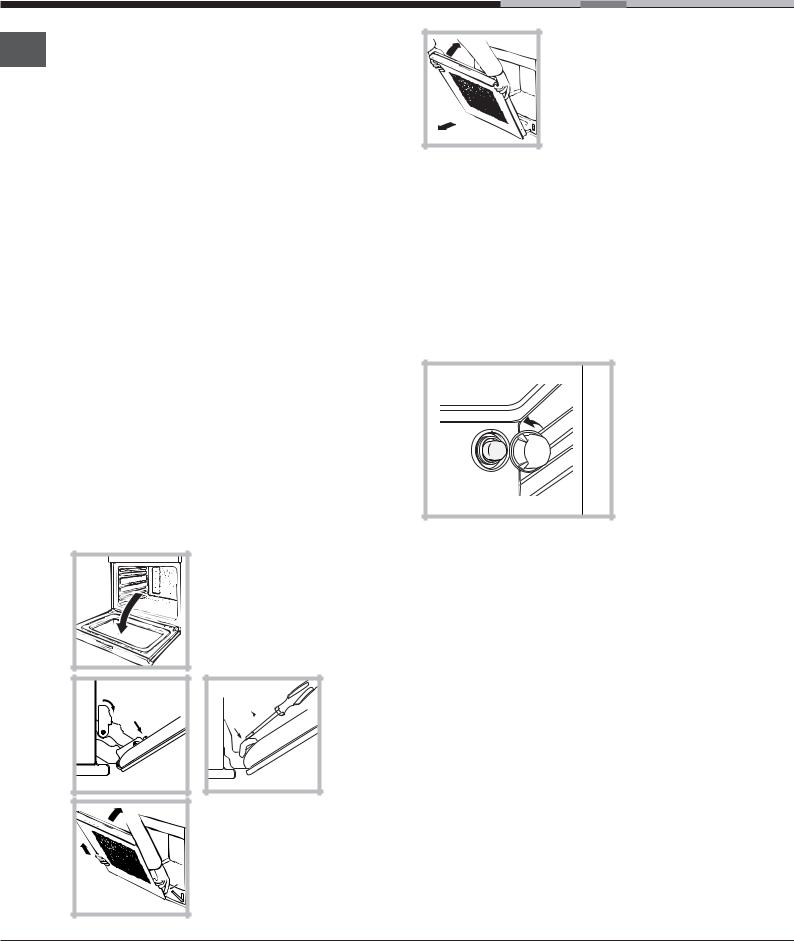
Care and maintenance
Switching the appliance off
GB
Disconnect your appliance from the electricity supply before carrying out any work on it.
Cleaning the appliance
•The stainless-steel or enamel-coated external parts and the rubber seals may be cleaned using a sponge that has been soaked in lukewarm water and neutral soap. Use specialised products for the removal of stubborn stains. After cleaning, rinse and dry thoroughly. Do not use abrasive powders or corrosive substances.
•The inside of the oven should ideally be cleaned after each use, while it is still lukewarm. Use hot water and detergent, then rinse well and dry with a soft cloth. Do not use abrasive products.
•All accessories - with the exception of the sliding racks - can be washed like everyday crockery, and are even dishwasher safe.
! Never use steam cleaners or pressure cleaners on the appliance.
Cleaning the oven door
Clean the glass part of the oven door using a sponge and a non-abrasive cleaning product, then dry thoroughly with a soft cloth. Do not use rough abrasive material or sharp metal scrapers as these could scratch the surface and cause the glass to crack.
To clean more thoroughly, you can remove the oven door.
1. Open the oven door fully
(see diagram).
2. Use a screwdriver to lift up
and turn the small levers F
located on the two hinges (see diagram).
F |
F |
F
3.Grip the door on the two external sides and close it approximately half way. Unlock the door by pressing on the clamps F, then pull the door towards you lifting it out of its seat (see diagram).*
3. Grip the door on the two outer sides and close it approximately half way. Pull the door towards you lifting it out of its seat (see diagram).* To replace the door, reverse this sequence.
Inspecting the seals
Check the door seals around the oven regularly. If the seals are damaged, please contact your nearest After-sales Service Centre (see Assistance). We recommend that the oven is not used until the seals have been replaced.
Replacing the light bulb
To replace the oven light bulb:
1.Remove the glass cover of the lamp-holder.
2.Remove the light bulb and replace it with a similar one: Wattage 25 W, cap E 14.
3.Replace the glass cover (see diagram).
* Only on certain models
22
